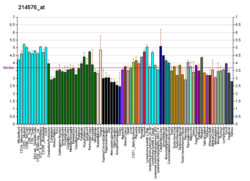KRT36
Protein-coding gene in the species Homo sapiens
| KRT36 | |||||||||||||||||||||||||||||||||||||||||||||||||||
|---|---|---|---|---|---|---|---|---|---|---|---|---|---|---|---|---|---|---|---|---|---|---|---|---|---|---|---|---|---|---|---|---|---|---|---|---|---|---|---|---|---|---|---|---|---|---|---|---|---|---|---|
| Identifiers | |||||||||||||||||||||||||||||||||||||||||||||||||||
| Aliases | KRT36, HA6, KRTHA6, hHa6, keratin 36 | ||||||||||||||||||||||||||||||||||||||||||||||||||
| External IDs | OMIM: 604540; MGI: 109364; HomoloGene: 88459; GeneCards: KRT36; OMA:KRT36 - orthologs | ||||||||||||||||||||||||||||||||||||||||||||||||||
| |||||||||||||||||||||||||||||||||||||||||||||||||||
| |||||||||||||||||||||||||||||||||||||||||||||||||||
| |||||||||||||||||||||||||||||||||||||||||||||||||||
| |||||||||||||||||||||||||||||||||||||||||||||||||||
| |||||||||||||||||||||||||||||||||||||||||||||||||||
| Wikidata | |||||||||||||||||||||||||||||||||||||||||||||||||||
| |||||||||||||||||||||||||||||||||||||||||||||||||||
Keratin, type I cuticular Ha6 is a protein that in humans is encoded by the KRT36 gene.[5][6][7]
The protein encoded by this gene is a member of the keratin gene family. This type I hair keratin is an acidic protein which heterodimerizes with type II keratins to form hair and nails. The type I hair keratins are clustered in a region of chromosome 17q12-q21 and have the same direction of transcription.[7]
References
- ^ a b c GRCh38: Ensembl release 89: ENSG00000126337 – Ensembl, May 2017
- ^ a b c GRCm38: Ensembl release 89: ENSMUSG00000020916 – Ensembl, May 2017
- ^ "Human PubMed Reference:". National Center for Biotechnology Information, U.S. National Library of Medicine.
- ^ "Mouse PubMed Reference:". National Center for Biotechnology Information, U.S. National Library of Medicine.
- ^ Rogers MA, Winter H, Wolf C, Heck M, Schweizer J (Nov 1998). "Characterization of a 190-kilobase pair domain of human type I hair keratin genes". J Biol Chem. 273 (41): 26683–91. doi:10.1074/jbc.273.41.26683. PMID 9756910.
- ^ Schweizer J, Bowden PE, Coulombe PA, Langbein L, Lane EB, Magin TM, Maltais L, Omary MB, Parry DA, Rogers MA, Wright MW (Jul 2006). "New consensus nomenclature for mammalian keratins". J Cell Biol. 174 (2): 169–74. doi:10.1083/jcb.200603161. PMC 2064177. PMID 16831889.
- ^ a b "Entrez Gene: KRT36 keratin 36".
Further reading
- Fuchs E, Weber K (1994). "Intermediate filaments: structure, dynamics, function, and disease". Annu. Rev. Biochem. 63: 345–82. doi:10.1146/annurev.bi.63.070194.002021. PMID 7979242.
- Yu J, Yu DW, Checkla DM, et al. (1993). "Human hair keratins". J. Invest. Dermatol. 101 (1 Suppl): 56S–59S. doi:10.1111/1523-1747.ep12362635 (inactive 2024-04-03). PMID 7686952.
{{cite journal}}: CS1 maint: DOI inactive as of April 2024 (link) - Ewing RM, Chu P, Elisma F, et al. (2007). "Large-scale mapping of human protein-protein interactions by mass spectrometry". Mol. Syst. Biol. 3 (1): 89. doi:10.1038/msb4100134. PMC 1847948. PMID 17353931.
- Olsen JV, Blagoev B, Gnad F, et al. (2006). "Global, in vivo, and site-specific phosphorylation dynamics in signaling networks". Cell. 127 (3): 635–48. doi:10.1016/j.cell.2006.09.026. PMID 17081983. S2CID 7827573.
- Strausberg RL, Feingold EA, Grouse LH, et al. (2003). "Generation and initial analysis of more than 15,000 full-length human and mouse cDNA sequences". Proc. Natl. Acad. Sci. U.S.A. 99 (26): 16899–903. Bibcode:2002PNAS...9916899M. doi:10.1073/pnas.242603899. PMC 139241. PMID 12477932.
- Langbein L, Rogers MA, Winter H, et al. (1999). "The catalog of human hair keratins. I. Expression of the nine type I members in the hair follicle". J. Biol. Chem. 274 (28): 19874–84. doi:10.1074/jbc.274.28.19874. PMID 10391933.
- v
- t
- e
Proteins of the cytoskeleton
| Microfilaments and ABPs |
| ||||||||||||||||
|---|---|---|---|---|---|---|---|---|---|---|---|---|---|---|---|---|---|
| Intermediate filaments |
| ||||||||||||||||
| Microtubules and MAPs |
| ||||||||||||||||
| Catenins | |||||||||||||||||
| Membrane | |||||||||||||||||
| Other |
See also: cytoskeletal defects
 | This article on a gene on human chromosome 17 is a stub. You can help Wikipedia by expanding it. |
- v
- t
- e
















